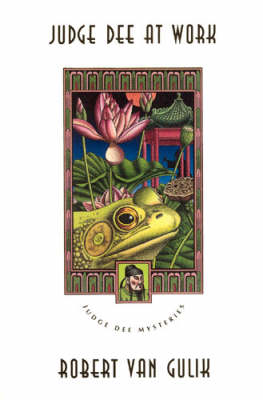Judge Dee Mystery
4 total works
The Monkey and The Tiger includes two detective stories, The Morning of the Monkey and The Night of the Tiger. In the first, a gibbon drops an emerald in the open gallery of Dee's official residence, leading the judge to discover a strangely mutilated body in the woods--and how it got there. In the second, Dee is traveling to the imperial capital to assume a new position when he is separated from his escort by a flood. Marooned in a large country house surrounded by fierce bandits, Dee confronts an apparition that helps him solve a mystery.
Judge Dee presided over his Imperial Chinese court with a unique brand of Confucian justice. A near-mythic figure in China, he distinguished himself as a tribunal magistrate, inquisitor, and public avenger. Long after his death, accounts of his exploits were celebrated in Chinese folklore and later immortalized by Robert van Gulik in his electrifying mysteries. These lively and historically accurate tales, written by a Dutch diplomat and scholar during the 1950s and '60s and brought back into print to critical acclaim in the 1990s, have entertained a devoted following around the world. Van Gulik's Judge Dee stories often based on actual cases and illustrated with the author's charming line drawings, offer vivid insight into life in traditional China. The eight short stories in "Judge Dee at Work" cover a decade during which the judge served in four different provinces of the Tang Empire. From the suspected treason of a general in the Chinese army to the murder of a lonely poet in his garden pavilion, the cases here are among the most memorable in the "Judge Dee" series.
It all begins on the night of the Poo-yang dragonboat races in AD 699: a drummer in the leading boat collapses, and the body of a beautiful young woman turns up in a deserted country mansion. There, Judge Dee - tribunal magistrate, inquisitor, and public avenger - steps in to investigate the murders and return order to the Tang Dynasty.In "The Emperor's Pearl", the judge discovers that these two deaths are connected by an ancient tragedy involving a near-legendary treasure stolen from the Imperial Harem one hundred years earlier. The terrifying figure of the White Lady, a river goddess enshrined on a bloodstained altar, looms in the background of the investigation. Clues are few and elusive, but under the expert hand of Robert van Gulik, this mythic jigsaw puzzle assembles itself into a taut mystery.
Judge Dee presided over his Imperial Chinese court with a unique brand of Confucian justice. A near-mythic figure in China, he distinguished himself as a tribunal magistrate, inquisitor, and public avenger. Long after his death, accounts of his exploits were celebrated in Chinese folklore and later immortalized by Robert van Gulik in his electrifying mysteries. These lively and historically accurate tales, written by a Dutch diplomat and scholar during the 1950s and '60s and brought back into print to critical acclaim in the 1990s, have entertained a devoted following around the world. Van Gulik's Judge Dee stories often based on actual cases and illustrated with the author's charming line drawings, offer vivid insight into life in traditional China. Poisoned plums, a cryptic scroll picture, passionate love letters, and a hidden murderer with a penchant for torturing and killing women lead Judge Dee to the heart of the Governor's garden maze and the answers to three interwoven mysteries.
"The Chinese Maze Murders" represents Robert van Gulik's first venture into writing suspense novels after the success of Dee Gong An, his translation of an anonymous Chinese detective novel from the sixteenth century.
"The Chinese Maze Murders" represents Robert van Gulik's first venture into writing suspense novels after the success of Dee Gong An, his translation of an anonymous Chinese detective novel from the sixteenth century.

